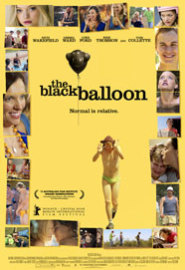
THE BLACK BALLOON
Australia, 2008
Directed by Elisa Down
Australian Catholic Film Office (SIGNIS Australia) award, 2008.
SHORT REVIEW
This is a moving and sensitive film about a handicapped young man, Charlie, who is mentally challenged and suffers from autism. He is the focus of a caring and loving family – chaotic and struggling – which is constantly frustrated by his shifting moods, and outrageous behaviour. The human spirit soars above heartbreak in a movie that illustrates the values of compassion, caring and love of a human person that lie behind the SIGNIS and Interfaith awards. The movie’s display of these virtues contrasts with the cruelty of those who would prefer to disparage handicap than face up to its reality. The film is funny at times, always confronting in one way or another, but above all warm in its genuine spirit of tolerance and understanding.
LONG REVIEW
This film premiered at Berlin’s International Film Festival in February, 2008, where it received the award for the best feature–length film in the Generation 14 plus category. It is a first feature length debut for Elissa Down, who directs a semi-autobiographical account of a family’s attempts to cope with the frustrations of caring for Charlie, a severely autistic young man (superbly played by Luke Ford). The film is a story about family, the permanency of love, finding love, growing-up, and disability. It is a moving and thoroughly authentic account of the ups-and-downs, and heartbreaking effects of autism on a chaotic family. Toni Collette plays the role of Charlie’s mother who is ordered to stay in bed to preserve her pregnancy. She gives over the immediate caring of Charlie to her son, Thomas (Rhys Wakefield) who is tested almost in every way by Charlie, his older brother. Thomas’ attraction to a girl friend at school (Gemma Ward) is compromised by Charlie’s behaviour and the relationship between Charlie and Thomas goes astray, and has to be discovered again.
The love of the family members is offset by the cruelty and harshness of the world outside the family, which can’t cope with Charlie’s obvious disabilities. Thomas is made the butt of cruel jokes at school and he has to respond to false preconceptions and attitudes about his mentally handicapped brother. The heart of the movie is displayed, not by authoritative statements or opinions, but by the humanity of those who sensitively show their love for a fellow human being they are committed to, and who is an integral part of their family unit.
This is not a perfect movie in any way. It comes to a heart-warming end that provides convenient closure, and it is a little stereotyped in its treatment of Australian suburbia. But the film offers us a profoundly moving account of caring people whose love for one of their own is tested almost beyond the limit. As a pro-family and pro-disability film, and often unnerving to watch, it stands as a powerful testimony to the fortitude of the human spirit and teaches us many lessons about love and survival.
CRITERIA FOR FILM REVIEWING
The primary criterion for assessing a film is that of “Quality.” This term, however, is an elusive one and represents many components parts. One looks to the adequacy of direction, acting, script, cinematography, art design, music, and production to name just a few of them. The component parts that are essential to my judgement of overall quality are direction and acting. If direction is not tight, sensitive and probing, and the film is poorly acted, then the presence of good cinematography, script, editing, and production, will have considerable trouble in filling the gap.
In judging quality, one must, I think, inevitably take on board the genre, which the film represents. This enhances relativity in the judgement process and allows one to compare the film indirectly with other movies like it, or films with similar aims. The context that surrounds a judgement of particular quality clearly varies as to whether the film achieves high quality in a particular genre; genre provides the context one brings to bear on the judgement of quality, and it can very much differ in terms of whether the film aims for comedy, high adventure, philosophical or introspective reflection about life (or life’s issues), fantasy, or the targeting of adult themes. Assessment of quality changes its character for the kind or type of movie one is considering. Only when genre is considered in relation to the judgement process can one understand the following list of quality films: “Vertigo”, “Fear Eats the Soul”, “2001: A Space Odyssey”, “The Conversation”, “A Night at the Opera”, “Gone with the Wind”, “Witness”, “The Lord of the Rings “, “Man of Flowers”, “Wake in Fright”, “Dr. No”, “The Seventh Seal”, “Citizen Kane”, “The Wages of Fear”, “Hunger”, “Some like it Hot”, “Deliverance”, “The Exterminating Angel”, “Blue Velvet”, “The Graduate”, “Klass”, and “Don’t Look Now”. This list illustrates films across different genres, and each film that is mentioned in the list (which is not exhaustive) merits, I believe, a judgement of high quality.
For film criticism of any kind, there are always natural preconceptions, biases, or suppositions on the reviewer’s part. This statement is a truism for everyone; no-one is immune from personal preconceptions when assessing subjectively the quality of a film, or book, or other artistic product. Good film criticism should not obscure what those prejudices might be, and should recognise when judgements about quality are being affected by them. The best of film criticism should convey some awareness of what preconceptions exist that might affect the judgement of quality that is being expressed. A judgement of quality is inherently subjective, not objective. However, the criteria for film criticism should be applied as objectively as possible.
Films may deal with positive or negative issues. Films that excel are those that leave one with a very meaningful experience of a better, or different understanding of some aspect of the human condition. A film carries a distorted message if it is inherently prejudicial or projects malice at its core. In talking about the human condition, however, there is enormous scope for the display of human frailty and inconsistency, and many excellent movies are about human weakness. Many outstanding movies also depict a bleak and dark view of human nature, and many illustrate that darkness superbly. A film may be about war, abuse, savagery, unendurable stress, or about the pursuit of happiness, whimsy, or joy. But quality-films ideally should be able to demonstrate an increment in our understanding and appreciation of the meaning of a human, social, or cultural problem or issue in any of these contexts; and the movie’s striving toward resolution should ideally be accompanied by subjective recognition on the reviewer’s part of ways in which his or her experience, and others’ experience, may be affected.
Ultimately, one looks for quality in a film that points the way forward, or provides a deeper meaning, or a message about what one does to avoid not being able to achieve that kind of an advance. In the final analysis, quality movies are always internalised in their effects. If they have impact, they are movies that affect us, arouse our emotions, make us think, and move us forward cognitively and emotionally in some way. It is transparently obvious when the values in a film that lacks quality are displayed falsely, or are projected in a pretentious or superficial way. Values must ring authentically true for the Director, they must be communicated either implicitly or explicitly in the film, and they must be reflected in the acting.
There is a real challenge for a reviewer to define the criteria, when he or she comes out of the cinema, and chooses to describe a film as “magnificent”. It is hard to generalise in this category, but when I use this term (and it is to be used sparingly) I look for taut, intelligent direction, evidence of high energy and expertise in the film’s production and direction, excellent cinematography, and outstanding acting; and such a movie has to aim for effects that are creatively different or distinct in definable ways. Movies at this level of quality must also achieve total integrity and bring their component parts together into an artistic or aesthetic whole. Magnificent films leave you profoundly affected and inspired as a result of seeing them, and they should stand the test of time.

BIOGRAPHY
PETER SHEEHAN graduated from the University of Sydney, Australia, with a PhD in Psychology in 1965. He has been on the staff at many Universities, that include The City University of the City of New York, The University of Queensland (Australia), and the Australian Catholic University. In this last position, he served as the University’s Vice-Chancellor? for ten years from 1998 - 2008.
He has held the office of President of the Academy of the Social Sciences in Australia (1991-1993), and was Deputy Chair and then Chair (1986-1987) of the Australian Cinematographic Films Board of Review. The Films Board of Review is responsible for final determination of the classification of cinema films in Australia, following appeals on censorship ratings.
He was Member of the Australian Broadcasting Tribunal’s National Inquiry into Violence on Television, and has served as a SIGNIS member for the Brisbane International Film Festival's Interfaith Jury, and the Festroia International Film Festival's SIGNIS Jury, Setubal, Portugal. Currently, he is Chair of the Queensland Catholic Education Commission, and Associate of the National Catholic Office for Film and Broadcasting.